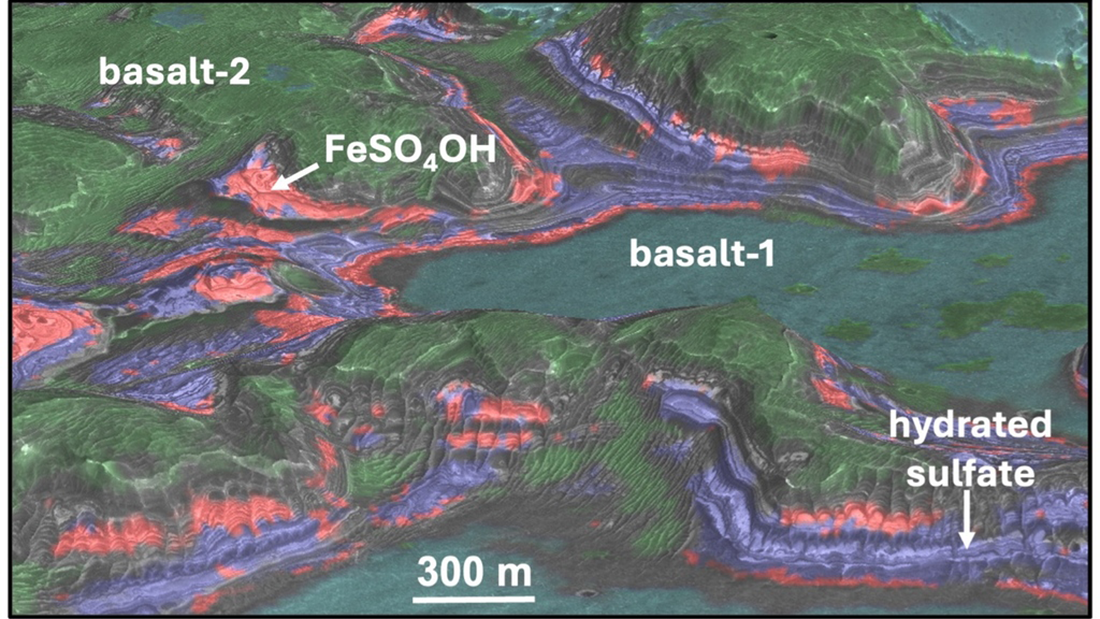A team of scientists studying strange spectral lines observed on Mars may have discovered a previously unknown mineral.
For nearly two decades, scientists have been receiving data from the Mars Reconnaissance Orbiter, constantly in orbit around Mars. On board the orbiter, the Compact Reconnaissance Imaging Spectrometer for Mars (CRISM) analyzes the spectra of the planet’s surface below, identifying the elements present.
“Sulfate minerals are significant components of the martian surface and provide clues about the martian geochemical environment,” the team from the SETI Institute and NASA Ames write in their study. “One unusual Fe-sulfate phase has been intriguing Mars scientists for over a decade due to its unique spectral bands that are distinct from any known minerals and its occurrence in layered sedimentary rocks.”
In the Valles Marineris region and the so-called “chaotic terrains” within it, there are signs that the landscape was carved by huge floods in the distant past. But as the water dried up (either being lost to space or the ground below), layers of magnesium sulfate and iron deposits were left behind at the surface, providing evidence of the water that once sat there.
Observations of the area found several known hydrated iron and magnesium sulfates, including rozenite (FeSO4·4H2O), szomolnokite (FeSO4·H2O), and kieserite (MgSO4·H2O). But in certain areas, CRISM found something that scientists couldn’t identify.
“An unusual spectral band at 2.236 µm was discovered in CRISM spectra of Mars at the plateau bordering Juventae Chasma and in Aram Chaos and has provided a challenge for mineral identification for over 15 years because this spectral band is not consistent with any known minerals.”
In the study, the team identified a potentially new mineral – ferric hydroxysulfate (Fe3+SO4OH) – created when other hydrated ferrous sulfates are heated above 100°C (212°F). According to the team’s work, this mineral closely matches the observed spectral band seen by CRISM.
“Our experiments suggest that this ferric hydroxysulfate only forms when hydrated ferrous sulfates are heated in the presence of oxygen,” postdoctoral researcher Dr Johannes Meusburger at NASA Ames explained in a statement. “While the changes in the atomic structure are very small, this reaction drastically alters the way these minerals absorb infrared light, which allowed identification of this new mineral on Mars using CRISM.”
On Mars, this mineral appears to be restricted to only a few small regions, leading the team to believe that it may have been formed above a warm geothermal source.

The mineral was likely created above a thermal source.
Image credit: SETI Institute and NASA’s Ames Research Center
These sorts of temperatures are not seen on Mars in the recent past. However, the team suggests that the minerals may have formed more recently than you might expect from previous work, possibly being created less than 3 billion years ago in the Amazonian period. If correct, that could mean that Mars was chemically and thermally active more recently than we once believed, potentially making it capable of supporting life for longer.
More work is needed, but for now, be satisfied that scientists may have identified a new mineral on another planet, and synthesized it on Earth.
“The material formed in these lab experiments is likely a new mineral due to its unique crystal structure and thermal stability,” Dr Janice Bishop, senior research scientist at the SETI Institute and NASA’s Ames Research Center, added. “However, scientists must also find it on Earth to officially recognize it as a new mineral.”
The study is published in Nature Communications.
Source Link: An Entirely New Mineral May Have Been Found On Mars, Solving 20-Year-Old Mystery